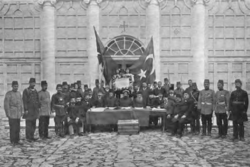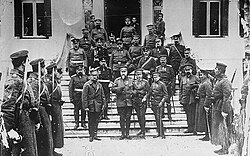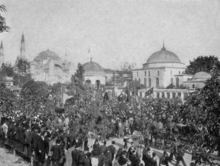
The Young Turks was a broad opposition movement in the late Ottoman Empire agitating against Sultan Abdul Hamid II's absolutist regime. The most powerful organization of the movement, and the most conflated, was the Committee of Union and Progress (CUP), though its goals, strategies, and membership continuously morphed throughout Abdul Hamid's reign. By the 1890s, the Young Turks were mainly a loose and contentious network of intelligentsia exiled in Western Europe and Egypt that made a living by selling their newspapers to secret subscribers.
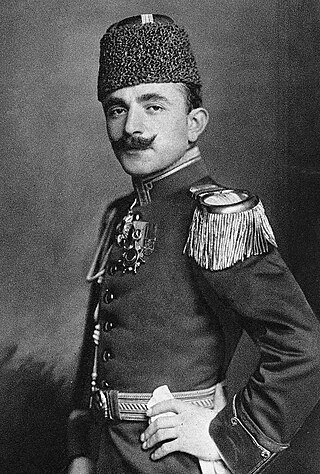
İsmail Enver, better known as Enver Pasha, was an Ottoman military officer, revolutionary, and convicted war criminal who formed one-third of the dictatorial triumvirate known as the "Three Pashas" in the Ottoman Empire.
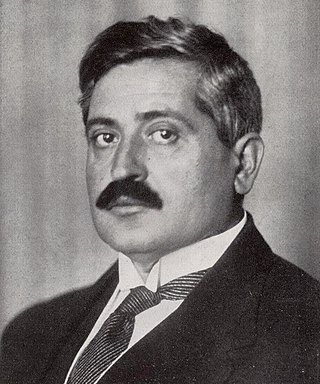
Mehmed Talaat, commonly known as Talaat Pasha or Talat Pasha, was an Ottoman politician and convicted war criminal who served as the de facto leader of the Ottoman Empire from 1913 to 1918. Talaat Pasha was chairman of the Union and Progress Party, which operated a one-party dictatorship in the Empire; during World War I he became Grand Vizier. He was one of the perpetrators of the Armenian genocide and other ethnic cleansings during his time as Minister of Interior Affairs.

The Young Ottomans were a secret society established in 1865 by a group of Ottoman intellectuals who were dissatisfied with the Tanzimat reforms in the Ottoman Empire, which they believed did not go far enough. The Young Ottomans sought to transform the Ottoman society by preserving the Empire and modernizing it along the European tradition of adopting a constitutional government. Though the Young Ottomans were frequently in disagreement ideologically, they all agreed that the new constitutional government should continue to be at least somewhat rooted in Islam. To emphasize "the continuing and essential validity of Islam as the basis of Ottoman political culture" they attempted to syncretize an Islamic jurisprudence with liberalism and parliamentary democracy. The Young Ottomans sought for new ways to form a government like the European governments, especially the constitution of the Second French Empire. Among the prominent members of this society were writers and publicists such as İbrahim Şinasi, Namık Kemal, Ali Suavi, Ziya Pasha, and Agah Efendi.

The dissolution of the Ottoman Empire (1908–1922) was a period of history of the Ottoman Empire beginning with the Young Turk Revolution and ultimately ending with the empire's dissolution and the founding of the modern state of Turkey.

The Second Constitutional Era was the period of restored parliamentary rule in the Ottoman Empire between the 1908 Young Turk Revolution and the 1920 dissolution of the General Assembly, during the empire's twilight years.

The 31 March incident was a political crisis within the Ottoman Empire in April 1909, during the Second Constitutional Era. The incident broke out during the night of 30–31 Mart 1325 in Rumi calendar, thus named after 31 March where March is the equivalent to Rumi month Mart. Occurring soon after the 1908 Young Turk Revolution, in which the Committee of Union and Progress (CUP) had successfully restored the Constitution and ended the absolute rule of Sultan Abdul Hamid II, it is sometimes referred to as an attempted countercoup or counterrevolution. It consisted of a general uprising against the CUP within Istanbul, largely led by reactionary groups, particularly Islamists opposed to the secularising influence of the CUP and supporters of absolutism, although liberal opponents of the CUP within the Liberty Party also played a lesser role. The crisis ended after eleven days, when troops loyal to the CUP restored order in Istanbul and deposed Abdul Hamid.

Starting in the 19th century the Ottoman Empire's governing structure slowly transitioned and standardized itself into a Western style system of government, sometimes known as the Imperial Government. Mahmud II initiated this process following the disbandment and massacre of the Janissary corps, at this point a conservative bureaucratic elite, in the Auspicious Incident. A long period of reform known as the Tanzimat period started, which yielded much needed reform to the government and social contract with the multicultural citizens of the empire.

The Constitution of the Ottoman Empire was the first and only constitution of the Ottoman Empire. Written by members of the Young Ottomans, particularly Midhat Pasha, during the reign of Sultan Abdul Hamid II, the constitution was in effect from 1876 to 1878 in a period known as the First Constitutional Era, and from 1908 to 1922 in the Second Constitutional Era. After Abdul Hamid's political downfall in the 31 March Incident, the Constitution was amended to transfer more power from the sultan and the appointed Senate to the popularly-elected lower house: the Chamber of Deputies.

Çerçiz Topulli was an Albanian revolutionary and guerrilla fighter involved in the national movement operating in the mountainous areas of southern Albania. He was the younger brother of Bajo Topulli. He was known for fighting the Ottomans in 1907 and 1908 and then after they left, the Greeks in 1913 and 1914 during the Balkan Wars.

Ibrahim Starova, also Ibrahim Bërzeshta, better known as Ibrahim Temo, was an Ottoman-Albanian politician, revolutionary, intellectual, and a medical doctor by profession. Temo was the original founder of the Committee of Union and Progress (CUP).

The Chamber of Deputies of the Ottoman Empire was the lower house of the General Assembly, the Ottoman Parliament. Unlike the upper house, the Senate, the members of the Chamber of Deputies were elected by the general Ottoman populace, although suffrage was limited to males of a certain financial standing, among other restrictions that varied over the Chamber's lifetime.

Mehmed Ferid Pasha was an Ottoman statesman. He served as Grand Vizier of the Ottoman Empire from 15 January 1903 until 22 July 1908, at the time when the Sultan restored the 1876 Constitution following the Young Turk Revolution. Other than Ottoman Turkish he spoke the Albanian, Arabic, French, Italian, and Greek languages.

Ahmed Niyazi Bey was an Ottoman revolutionary, who was the bey of the Resne area in the late 19th and early 20th centuries. An ethnic Albanian, Niyazi was one of the heroes of the 1908 Young Turk Revolution and of suppressing the 1909 countercoup as he played leading roles in both events. Niyazi is also known for the Saraj, a French-style estate he built in Resne.

The Committee of Union and Progress, refers to several revolutionary groups and a political party active between 1889 and 1926 in the Ottoman Empire and the Republic of Turkey. The foremost faction of the Young Turks, the CUP instigated the 1908 Young Turk Revolution, which ended absolute monarchy and began the Second Constitutional Era. After an ideological transformation, from 1913 to 1918, the CUP ruled the empire as a dictatorship and committed genocides against the Armenian, Greek, and Assyrian peoples as part of a broader policy of ethnic erasure during the late Ottoman period. The CUP and its members have often been referred to as Young Turks, although the movement produced other political parties as well. Within the Ottoman Empire its members were known as İttihadcılar ('Unionists') or Komiteciler ('Committeemen').

Eyüp Sabri, Ohrili Eyüp Sabri (1876-1950) known as Eyüp Sabri Akgöl after the 1934 Surname Law, was an Ottoman-Albanian revolutionary and one of the leaders of the Young Turk Revolution (1908).
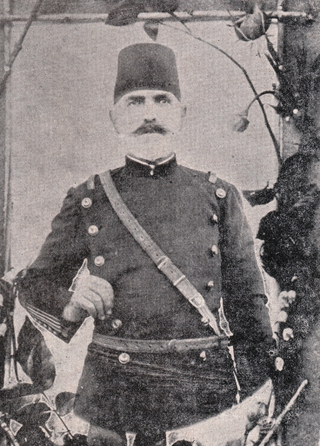
Shemsi Pasha (1846-1908) was an Ottoman-Albanian general.

Atıf Kamçıl, also known as Atif Bey, Atif Efendi (1880–1947) was an Ottoman revolutionary and Turkish politician.

Rexhep Pasha Mati was an Ottoman-Albanian marshal, governor and war minister.
